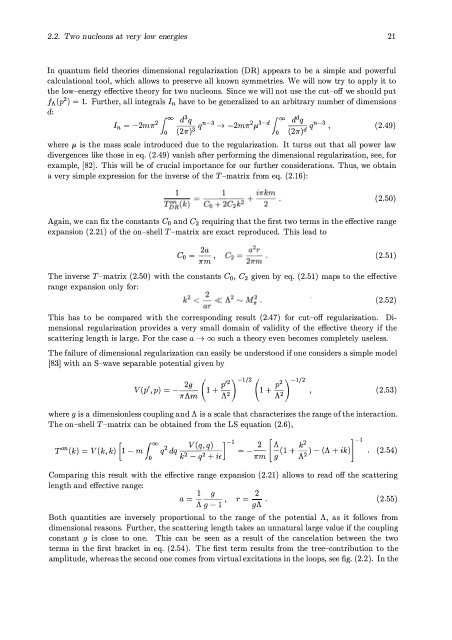The Nucleon-Nucleon Interaction in a Chiral Effective Field Theory
The Nucleon-Nucleon Interaction in a Chiral Effective Field Theory
The Nucleon-Nucleon Interaction in a Chiral Effective Field Theory
You also want an ePaper? Increase the reach of your titles
YUMPU automatically turns print PDFs into web optimized ePapers that Google loves.
2.2. Two nuc1eons at very low energies 21<br />
In quantum field theories dimensional regularization (DR) appears to be a simple and powerful<br />
calculational tool, which allows to preserve all known symmetries. We will now try to apply it to<br />
the low-energy 1. effective theory for two nueleons. S<strong>in</strong>ce we will not use the cut-off we should put<br />
JA(p2) = Further, all <strong>in</strong>tegrals In have to be generalized to an arbitrary number of dimensions<br />
d:<br />
1000 d3q 1000 ddq<br />
I - -2m7f2 -- q n __<br />
-3 ---+ -2m7f2J-L3-d q n-3<br />
n -<br />
(2.49)<br />
0 (27f)3 0 (27f)d '<br />
where f.L is the mass scale <strong>in</strong>troduced due to the regularization. It turns out that all power law<br />
divergences like those <strong>in</strong> eq. (2.49) vanish after perform<strong>in</strong>g the dimensional regularization, see, for<br />
example, [82]. This will be of crucial importance for our furt her considerations. Thus, we obta<strong>in</strong><br />
a very simple expression for the <strong>in</strong>verse<br />
1<br />
of the T-matrix from eq. (2.16):<br />
(2.50)<br />
Aga<strong>in</strong>, we can fix the constants Co and C2 requir<strong>in</strong>g that the first two terms <strong>in</strong> the effective range<br />
expansion (2.21) of the on-shell T-matrix are exact reproduced. This lead to<br />
Co = 2a<br />
7fm<br />
,<br />
(2.51)<br />
<strong>The</strong> <strong>in</strong>verse T-matrix (2.50) with the constants Co, C2 given by eq. (2.51) maps to the effective<br />
range expansion only for:<br />
(2.52)<br />
This has to be compared with the correspond<strong>in</strong>g result (2.47) for cut-off regularization. Dimensional<br />
regularization provides a very small doma<strong>in</strong> of validity of the effective theory if the<br />
scatter<strong>in</strong>g length is large. For the case a ---+ 00 such a theory even becomes completely useless.<br />
<strong>The</strong> failure of dimensional regularization can easily be understood if one considers a simple model<br />
[83] with an S-wave separable potential given by<br />
2) -1/2<br />
( 2 12) -1/2 ( V (pI, p) = - : 1 + � 1 + 7f m 2 � 2 ' (2.53)<br />
where 9 is a dimensionless coupl<strong>in</strong>g and A is a scale that characterizes the range of the <strong>in</strong>teraction.<br />
<strong>The</strong> on-shell T-matrix can be obta<strong>in</strong>ed from the LS equation (2.6),<br />
Ton(k) = V(k, k) [1 - m (oo q2 dq k2 V(q ; q) . ] -1 = _� [�(1 + A k :) - (A + ik)] -l . (2.54)<br />
io - q + ZE 7fm 9<br />
Compar<strong>in</strong>g this result with the effective range expansion (2.21) allows to read off the scatter<strong>in</strong>g<br />
1 length and effective range:<br />
-1 9 2<br />
- Ag ' r = gA . (2.55)<br />
Both quantities are <strong>in</strong>versely proportional to the range of the potential A, as it follows from<br />
dimensional reasons. Further, the scatter<strong>in</strong>g length takes an unnatural large value if the coupl<strong>in</strong>g<br />
constant 9 is elose to one. This can be seen as a result of the cancelation between the two<br />
terms <strong>in</strong> the first bracket <strong>in</strong> eq. (2.54). <strong>The</strong> first term results from the tree-contribution to the<br />
amplitude, whereas the second one comes from virtual excitations <strong>in</strong> the loops, see fig. (2.2). In the<br />
a - - -












